Fungus gnats are small flies that infest plants and lay eggs on the potting soil surface. The fungus gnat larvae and adults create significant problems for the greenhouse and indoor plant owners. Notably, the fungus gnat larvae are the serious trouble makers because they feed on organic matter and fungus.
The root damage leads to little to no growth in greenhouse plants. While in indoor plants, fungus gnat larvae negatively affect the cosmetic value.
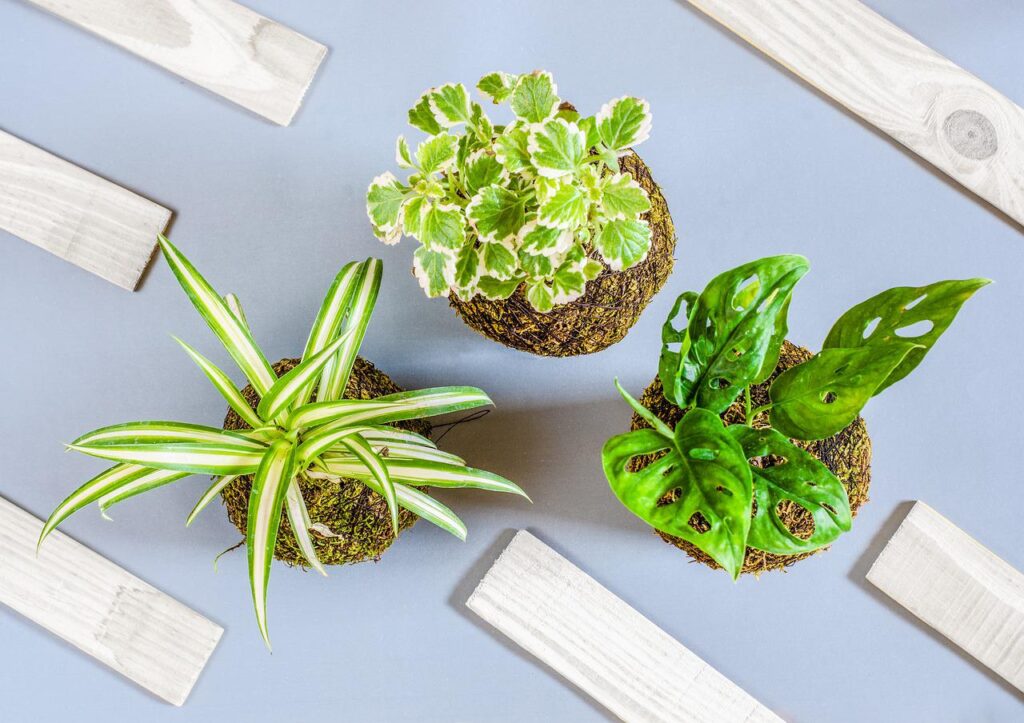
Houseplants decorating the interior spaces
It is wise to early detect the fungus gnat infestation to prevent the plants from being damaged. Most importantly, the adult gnat flies are harmless, but their transparent and yellowish larvae cause root damage and rot.
This write-up will provide information on fungus gnats and how we can manage them on houseplants effectively.
What Are Fungus Gnats?
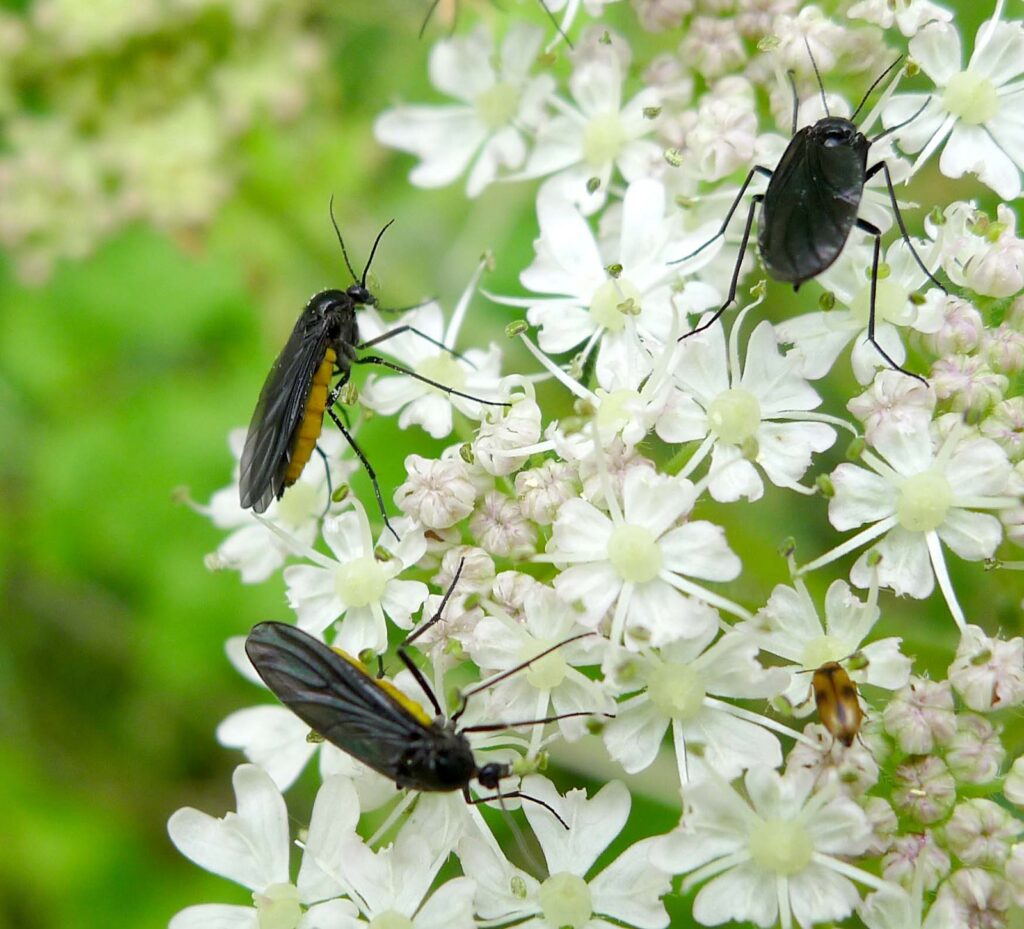
Black and dark-winged fungus gnats on host plant
Fungus gnats are members of the insect family Sciaridae. They are the most common pests of indoor plants with high humidity and moisture. The other places where fungus gnat infestations are high and problematic are nurseries, potted plants, landscapes, and gardens.
The adult fungus gnats first appear near light sources such as windows or near the potted plants. However, these flying insects become a nuisance when in high numbers, but it’s their larval stages they feed on plant roots.
Identification of Fungus Gnats
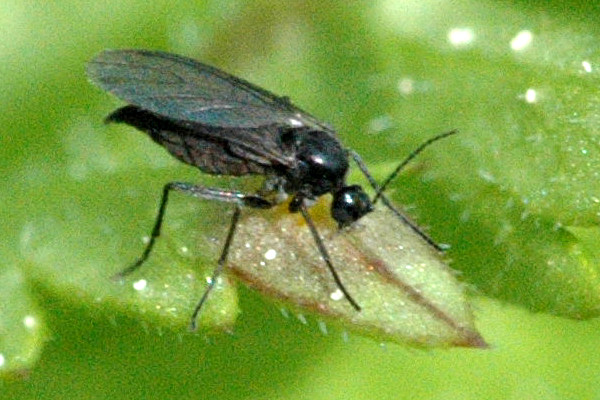
Adult fungus gnat on the leaves of host plant
The adult fungus gnats are dark and delicate-looking flies that resemble mosquitoes. They have long, narrow legs with segmented antennas longer than their head. Their large antennas distinguish them from other insects (shore flies) that feed on algae and organic matter. The shore flies have short bristle-like antennae.
RELATED: Fungus Gnats vs. Fruit Flies: How to Get Rid of Them on Houseplants?

An adult fungus gnat with long narrow legs and larger segmented antennas
The adult fungus gnats are 1/8 inches long, with large antennas extending over their head. Fungus gnats tend to have transparent wings but are not strong fliers. Instead, they emerge from the base of potted plants when disturbed during watering.
While the fungus gnat larvae are 1/4 inch long with shiny blackheads and long transparent bodies. The larvae vary in their body color from whitish to yellow and appear soft and shiny.
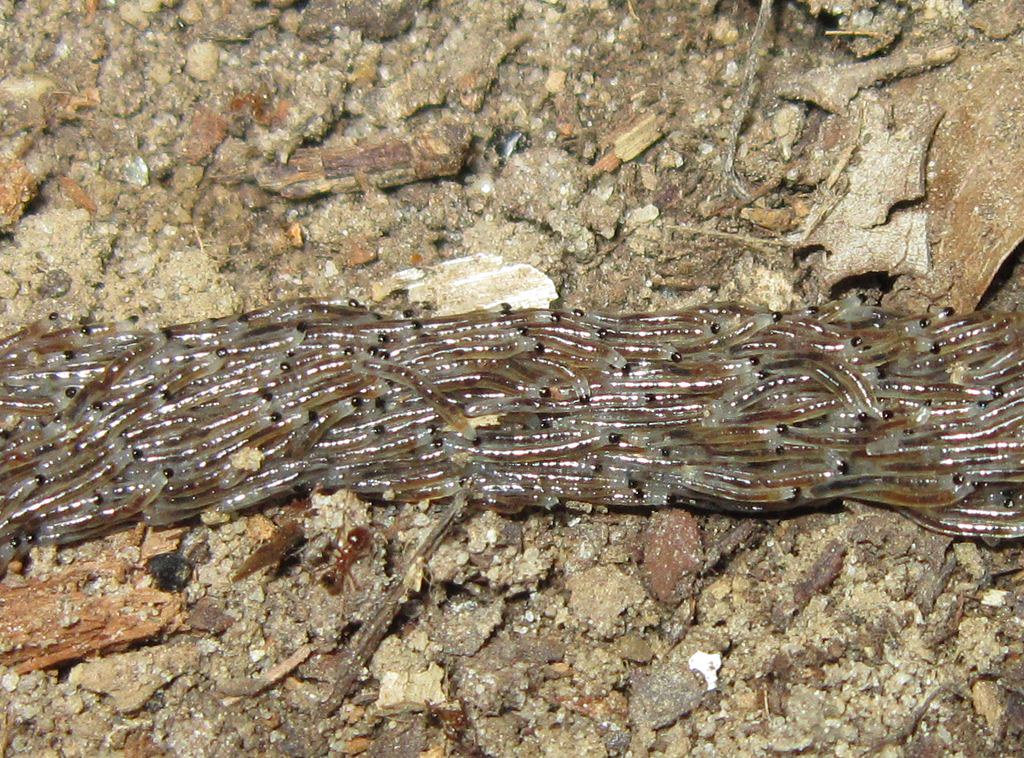
Fungus gnat larvae—the actual trouble makers in greenhouses, gardens, indoor spaces, and nurseries
These long and blackheads fungus gnat larvae feed on organic matter, decaying vegetation, and fallen, dead leaves. Moreover, the larvae eat root hairs, compost, leaf mold, pruned plant parts, and fungi.
During heavy populations of fungus gnat larvae, they leave slime trails on the surface of the media (soil surface) like the trails from slugs and snails.
RELATED: How to Prevent Gnats in Houseplants? Plus Effective Tips!

Fungus gnat larvae remain a unit, move as a unit, and feed as a unit
Life Cycle of Fungus Gnats
The life cycle of fungus gnats consists of four stages—an egg, larval, pupal, and adult stages. First, females lay tiny eggs in damp soil. Then, in each cycle, the female gnats lay up to 300 eggs which hatch within three days of egg-laying at 75ºF.
After hatching, the larvae feed on the young plant roots, organic debris, and fungi. The fungus gnat larvae remain active for tens of days, busy feeding on plant roots. Later on, the larvae undergo the pupal stage (a non-feeding and immobile stage).
The pupal stage lasts for three to four days before the young adults emerge from the soil and leave for the next-generation cycle. Fungus gnat adults only live for one week, and the entire life cycle from female to female completes within seventeen days.
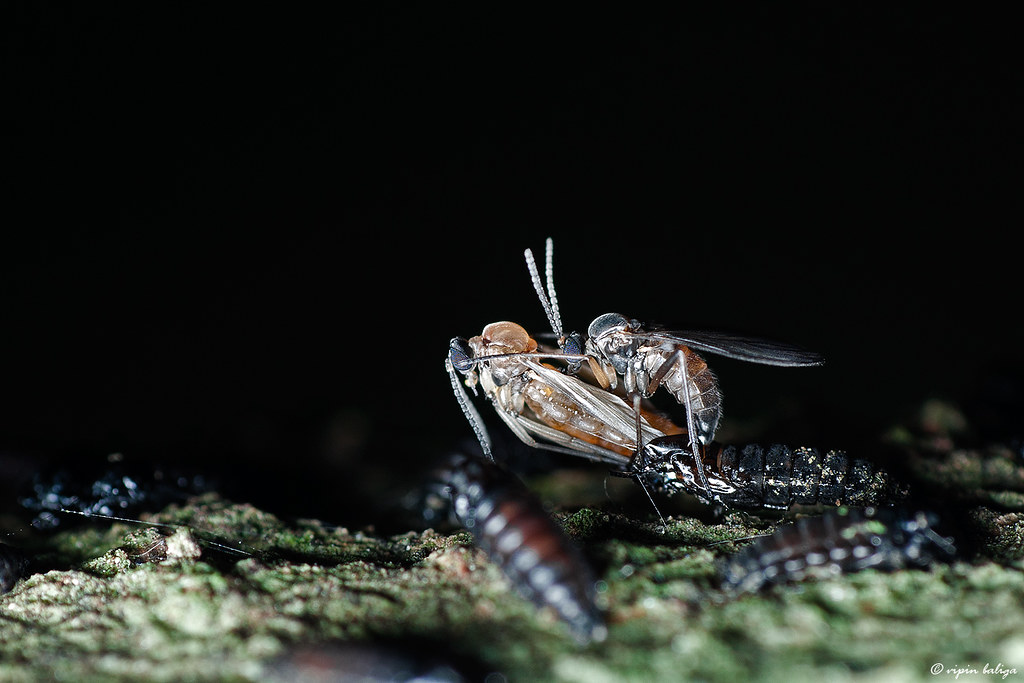
The mating process of fungus gnats
The more favorable the weather conditions, the more generations of fungus gnats are. Therefore, during warmer temperatures, there are overlapping generations of fungus gnats per plant.
Note: Fungus gnats remain active throughout the winter season in outdoor plants. While in indoor spaces, they remain active and reproduce speedily throughout the year.
Damaged Caused by Fungus Gnats
Fungus gnat adults do not cause any damage to plants, nor do they bite humans and pets. However, their presence is considered noisy and unpleasant around homes, offices, and light sources.
Fungus gnat larvae—the leading cause of damage when present in high numbers, eat organic mulch and plant roots and impact plant growth negatively.
The feeding damage of fungus gnat larvae includes:
- Stunted plant growth, particularly in young plants
- Death occurs in interior landscapes and plants due to larvae damage to roots
- The rate of wilting and death in plants is higher in organically rich soil because of fungus gnat larvae damage
The other causes of unhealthy roots and plant wilting are too much or too little water, root rot, and unhealthy soil conditions (waterlogging, poor drainage).
Management of Fungus Gnats
Adult fungus gnats live near plant bases at the soil surface or near light sources in interior spaces. However, fungus gnats also spend most of their life in the larval and pupal stages. So, most of the management practices are aimed at controlling larval stages. For example, reducing excess moisture and organic debris is crucial to lowering the fungus gnat larvae problem.
The following is a breakdown of practical approaches to killing fungus gnat larvae and adults:
- Use yellow sticky traps to capture the flying adults typically resting on plants and soil surfaces. In this way, you will be able to interfere with the fungus gnat life cycle and no more infestations. In addition to that, sticky traps will help determine the fungus gnat populations.
- Visual inspection for an adult fungus gnat infestation will determine whether the problem exists or not. You will observe fungus gnat adults resting on plants, windows, and soil.
- Besides looking for adults, monitor your plants for fungus gnats larvae because excess moist conditions, fungi, and organic material provide them food. Use raw potato pieces to monitor and control fungus gnat larvae.
- Do not overwater your indoor plants because excessive moisture will attract the problem and fungus gnat damage. Instead, provide your houseplants with good drainage conditions.
- Let the soil dry between every watering. Also, remove standing water and eliminate organic mulch, compost, and fertilizer near or around your plants. Because they provide the fungus gnat, adults save breeding sites.
- Improve the drainage ability of potting soil mix—increase the proportion of sand or perlite in the mix.
- Avoid excessive applications of manure, blood meal, and other decaying material.
- Do not apply partially composted organic material until it is wholly sterilized because it may contain the larvae and eggs of fungus gnats.
- Before planting your houseplants, completely pasteurize the plant pots and potting mix to destroy the eggs and larvae of fungus gnats.
- Fungus gnats have a wide range of predators that munch on them. It includes predatory mites, parasitic wasps, and beneficial nematodes.
- Beneficial bacteria are commercially available as Gnatrol. The frequent applications of Gnatrol on indoor plants provide fungus gnat control. However, it needs repeat applications for more extended protection.
- Predatory mites feed on the upper layer of moist soil. These mites feed on the fungus gnats larvae, eggs, pupae, thrips, and other soil-dwelling pests. However, they are effective biocontrol agents in outdoor gardens rather than houseplants.
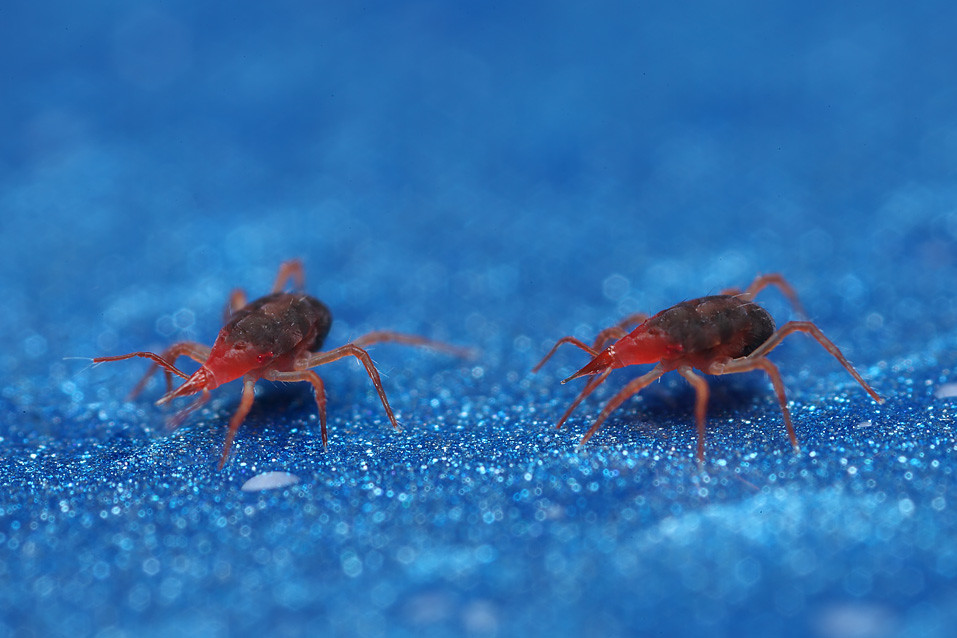
Predatory mites actively looking for prey—biological control agents
FAQs
What Can I Spray on my Plants to Get Rid of Gnats?
Spray your plants with neem oil, insecticidal soap, and horticultural oils to control fungus gnats. Apply neem oil dilution as a soil drench to suffocate the larvae, pupae, and eggs before completing their life stages. Furthermore, you can spray your plants with mild liquid dish soap to smother the soft bodies of damaging larvae.
Apply diatomaceous earth near the plant base to puncture the bodies of female fungus gnats and larvae (that will cause dehydration). Or disrupt the life cycle fungus gnats on infested plants by introducing the biological control agents.
What is the Best Gnat Killer?
The best gnat killers are
- Gnatrol
- Bonide BND951
- Yellow sticky trap
- Pyrethroids
Do Fungus Gnats Bite Humans?
No, the fungus gnat adult does not bite on humans and pets. However, they are harmful to plants (indoors and outdoors). The larvae of fungus gnats actively feed on the roots of young seedlings and destroy the plant’s natural nutrient absorption mechanism.
The fungus gnat problems in plants lead to:
- Stunted plant growth
- Yellowing and browning of leaves
- Loss of vigor
- Wilting of damaged plants due to root damage
Where Do Gnats Lay Eggs?
Adult fungus gnats lay eggs in moist soil or moist organic debris of plants. The habitats for their egg-laying are organic mulch, compost piles, dead, fallen leaves, and garden grass clippings.
Why Do I Have Gnats in my Plants?
Fungus gnat infestation is the presence of excessive moisture in your garden and houseplants. Also, the second factor is whether you are overwatering your plants or your plant pots have poor drainage. That’s why the gnats are coming back, again and again, to settle down.
It is also the immediate place for your houseplants to have organic compost piles or decaying material.
Will Fungus Gnats Go Away?
To get rid of fungus gnats completely, killing them at all life cycle stages is wiser. This is the only way they will go away completely. Otherwise, the adults will reproduce in moist soil, and the larvae will continue to feed on root hairs. So, both the adult stage and larvae will damage plants equally.
What Causes Fungal Gnats?
Fungus gnats infest the indoor spaces when there is enough moisture to support the growth of fungus and adults. Overwatering of houseplants and organic matter also attracts the fungus gnats. They hide and reproduce in these moisture-rich sites and injure plants. Moreover, the indoor spaces are also ideal for their rapid growth (able to complete their life cycle within two weeks).
Are House Gnats Harmful?
Fungus gnats are entirely harmless to humans and pets, but they are incredibly damaging to plants. The female lives near moist, rich potting soil and lays eggs. The eggs hatch into young crawlers, damaging the young seedlings’ roots. So, these house gnats are harmful to your favorite indoor plants.
Sources for Further Reading
- Bethke, J. A., & Dreistadt, S. H. (2013, August). Fungus Gnats Management Guidelines–UC IPM. University of California Statewide IPM Program. Retrieved May 8, 2022, from http://ipm.ucanr.edu/PMG/PESTNOTES/pn7448.html
- Colorado State University Extension. (2016a, April 15). Fungus Gnats as Houseplant and Indoor Pests – 5.584. Extension. Retrieved May 8, 2022, from https://extension.colostate.edu/topic-areas/insects/fungus-gnats-as-houseplant-and-indoor-pests-5-584/
- Dampier, J. (2009, April). Fungus Gnats on Houseplants. Wisconsin Horticulture. Retrieved May 8, 2022, from https://hort.extension.wisc.edu/articles/fungus-gnats-on-houseplants/
- Fungus gnats. (n.d.). Missouri Botanical Garden. Retrieved May 8, 2022, from https://www.missouribotanicalgarden.org/gardens-gardening/your-garden/help-for-the-home-gardener/advice-tips-resources/pests-and-problems/insects/flies/fungus-gnats.aspx
Now that you know how to deal with fungus gnats, make sure to read our other articles on how to control other plant pests:
How to Effectively Control Houseplant Pests?
Springtails on Houseplants & Effective Ways to Get Rid of Them?
What are the Best Practices to Get Rid of Thrips on Houseplants?







